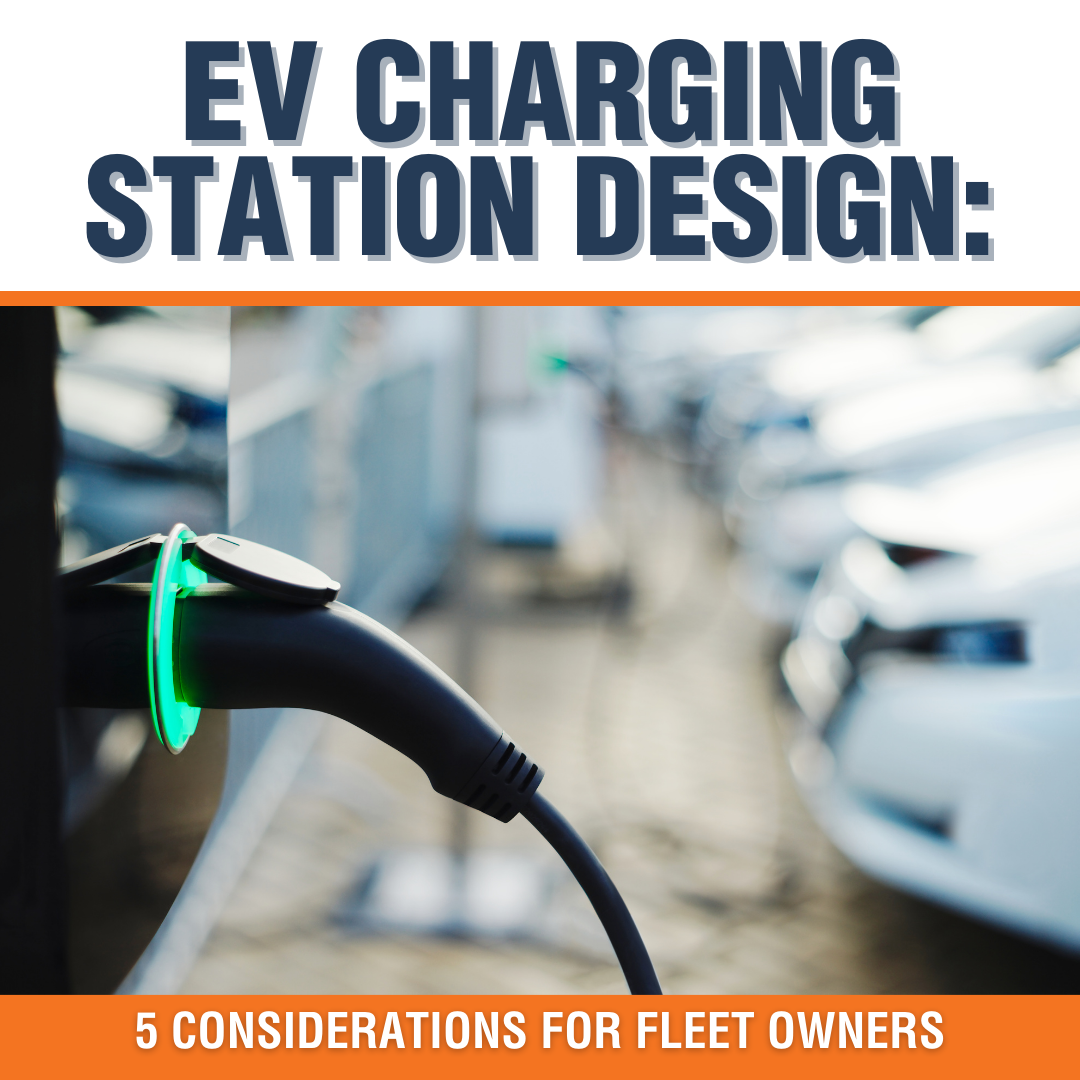We use cookies to make your experience better. To comply with the new e-Privacy directive, we need to ask for your consent to set the cookies. Learn more.
EV Charging Station Design: 5 Considerations for Fleet Owners
Passenger cars aren’t the only mode of transportation switching from gas to battery power. Light commercial vehicles—delivery vans, work pickups, cabover trucks—represented just 24,000 of the U.S.’s electric vehicles in 2021. By 2030, they’re expected to grow to nearly 4 million units. That means many fleet owners are currently trying to figure out how to make the transition. A big part of that project will be creating charging infrastructure. 
But what do you need to know about EV charging station design to ensure success? Here are 5 things to consider as you plan your charging systems for an electric work fleet.
1. What kind of chargers will you use?
Depending on the types of EVs in your fleet, typical available charge time, and overall demand, you may install some combination of EV chargers. The three technologies currently available for EV charging include:
- Level 1 Chargers. Level 1 charging involves a standard 120 volt AC outlet, like the kind found in residential homes. Because of its relatively low power output, level 1 charging can be quite slow, taking up to 20 hours or more to fully charge an EV.
- Level 2 Chargers. These chargers use 240 volt AC outlets, and typically require a dedicated circuit rated for 20 to 80 amps. That may require upgrades to the electrical system, but typically charges an EV battery in just four to eight hours.
- DC Fast Chargers. With direct current power, these chargers can restore EV batteries up to 80 percent capacity in just half an hour. This high power output usually requires utility upgrades and dedicated circuits.
According to a report by the New York State Energy Research and Development Authority and Transportation and Climate Initiative, Level 2 chargers are the most cost-effective option for today’s commercial EV fleets. DC fast chargers are the best choice for locations that need quick turnaround, however.
At any rate, the type of chargers you install in EV charging stations will govern decisions from electrical system upgrades to charger-mounting infrastructure. It’s the first decision you should make.
2. What’s the best site for a charging station?
With the right infrastructure, EV charging stations may be located inside parking garages or in open lots. Indoors or out, the ideal site will find a balance between the following characteristics:
- Plenty of space for larger-than-average parking spaces, which allow drivers to safely access charging cables and EV ports
- Distance from other high-traffic areas, such as building entrances and loading zones
- Adequate lighting for safe overnight operation
- Easy access to electrical infrastructure
- Legally designated for industrial/commercial fleet use
Choose a site that requires a minimum of heavy construction, such as digging trenches for electrical infrastructure or building new walls. Construction is one of the major costs associated with EV charging station design; the less you require, the more affordable your project will be.
3. Where will you mount EV chargers?
Your site choice will affect your options for mounting EV chargers. If chargers are located indoors, you may be able to mount them on walls. If you’re building outdoor charging stations, you’ll need EV charger stands that protect equipment while providing quick access to charger cables.
Choose an EV Charger Pedestal with integrated Cable Management Kits to protect equipment while providing quick access to charging cables. By mounting two chargers per stand, you can serve more vehicles with less space. Steel EV Charger Pedestals from BHS, Inc. feature heavy duty, weather-resistant construction, and come with easy-access EV Charger Cable Retractors installed (separate wall-mounted cable retractors are also available). They’re ideal for any fleet charging system, indoors or out.
4. How will you protect EV charging equipment from damage?
According to the National Electrical Code’s Article 625—specifically code 625.102 (B)—EV chargers must be stored at least 24 inches above the ground outside, and 18 inches up for indoor installations. Cables over 25 feet also require cable management systems like EV Charger Cable Retractors.
These standards provide some measure of protection for chargers and cables. But it’s also helpful to install curbs, Structural Bollards, or Structural Barrier Rails to protect charger stands from impact. These safety barriers also reduce tripping hazards for operators.
5. What sorts of signs or markings indicate charging locations?
After you choose your site, chargers, and mounts, EV charging station design becomes a question of traffic management. How will you label parking spaces and charger installations to keep traffic flowing safely and efficiently?
Luckily, others have studied the question of signage for electric vehicle supply equipment (EVSE). An Ecotality report for The EV Project recommends a standardized graphic, depicting a charger bearing the letters EV, either painted on the charging station’s parking space itself or on a highly visible sign post.
In addition to identifying charger stations, roads should be marked with clear traffic flow indicators, in compliance with the Federal Highway Administration’s Manual on Uniform Traffic Control Devices for Streets and Highways.
While these five questions can help you get started with EV charging station design, you’ll also need the assistance of experts—electricians, architects, and manufacturers of EV charger infrastructure. BHS, Inc. can help with that last item. Contact the BHS sales team at 1.800.BHS.9500 to learn more about EV Charger Pedestals and Cable Management Kits today.
